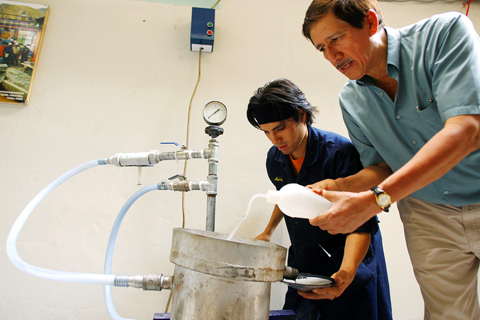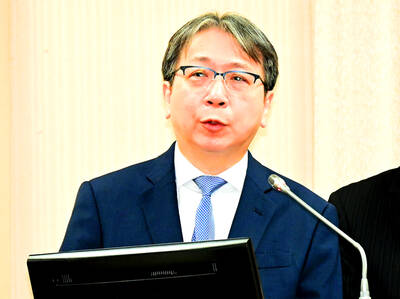Call it green gold. A Peruvian engineer says he has come up with an environmentally sound way to isolate gold from clumps of sand without using toxic mercury that wildcat miners in the Amazon basin rely on to extract the precious metal, then dump into rivers.
The small, cylindrical machine blends mineralized dirt with jets of pressurized air, water and biodegradable chemicals in a centrifugal motion that produces a cocktail of thousands of bubbles that rise to the surface attached to specks of gold.
“This is ethical gold, because it’s not using mercury. Small scale mining is a big employer, and the machine’s cost of operation is cheap,” Carlos Villachica, an engineer who developed the device, said inside his small lab in Peru’s capital, Lima.

PHOTO: REUTERS
While large, professional gold mines rely mainly on cyanide in sealed pools, mercury is used by millions of wildcat miners around the world. They buy hundreds of tonnes of it each year to extract gold from mud.
Environmentalists say much of it will eventually make its way into the food chain, causing health problems.
About 20 percent of gold in Peru is produced by wildcatters — people who mine, usually without formal permits, using picks and dredges.
The high concentration of gold produced by the device allows for direct melting of the precious metal, according to Villachica, who says it also conserves water, recycling up to 90 percent and as much as 70 percent of all chemicals used during the process.
The government has long struggled with curbing some 300,000 wildcat miners and reducing pollution in the Amazon basin.
Villachica said he was close to introducing the machine in the Madre de Dios region, where 70 percent of Peru’s wildcatters operate.
The machine would produce up to 95 percent of the gold obtained by using mercury by wildcat miners, who often put their own health at risk by exposing themselves to the toxic metal.
Villachica runs Smallvill, a Peruvian firm that focuses on green technology and has built a plant to clean waste water of the mining company Volcan.
However, his latest device is still unknown and it remains to be seen whether it can transform Peru’s mining industry.
Patrick Taylor and Corby Anderson, two colleagues at the Colorado School of Mines, say it remains to be seen what the invention is capable of doing.
“He might be reaping some gold, but we would need to see the results. He’s not going to produce pure gold, just a concentrate,” Anderson said.
But, Taylor said, there is room for testing new technologies.
“Even though I am unaware of this specific technology, how it works, and it’s utility for small gold miners, advances in technology are made often and this may be very useful. I am interested in learning more about it,” he said.
Peru is the world’s No. 6 producer of the precious metal and shipments of gold and other metals make up 60 percent of its exports.
Peruvian President Alan Garcia has passed laws to curb pollution by wildcatters, but they have protested against the new rules. A deadly clash with police this month forced the government to say it would revise the laws in Congress.
Villachica said people have contacted him from as far as Australia and Tanzania, asking him how to produce gold in an environmentally friendly manner.
Among the most interested is a local group of farmers and miners in the region of Cusco, the old Inca capital, who want to reopen a 16th century gold mine.
“It’s an environmental project that would benefit the community,” Samuel Solis, a community leader said. “They want to find gold like their ancestors using the green technology.”

The US government has signed defense cooperation agreements with Japan and the Philippines to boost the deterrence capabilities of countries in the first island chain, a report by the National Security Bureau (NSB) showed. The main countries on the first island chain include the two nations and Taiwan. The bureau is to present the report at a meeting of the legislature’s Foreign Affairs and National Defense Committee tomorrow. The US military has deployed Typhon missile systems to Japan’s Yamaguchi Prefecture and Zambales province in the Philippines during their joint military exercises. It has also installed NMESIS anti-ship systems in Japan’s Okinawa

‘WIN-WIN’: The Philippines, and central and eastern European countries are important potential drone cooperation partners, Minister of Foreign Affairs Lin Chia-lung said Minister of Foreign Affairs Lin Chia-lung (林佳龍) in an interview published yesterday confirmed that there are joint ventures between Taiwan and Poland in the drone industry. Lin made the remark in an exclusive interview with the Chinese-language Liberty Times (the Taipei Times’ sister paper). The government-backed Taiwan Excellence Drone International Business Opportunities Alliance and the Polish Chamber of Unmanned Systems on Wednesday last week signed a memorandum of understanding in Poland to develop a “non-China” supply chain for drones and work together on key technologies. Asked if Taiwan prioritized Poland among central and eastern European countries in drone collaboration, Lin

ON ALERT: Taiwan’s partners would issue warnings if China attempted to use Interpol to target Taiwanese, and the global body has mechanisms to prevent it, an official said China has stationed two to four people specializing in Taiwan affairs at its embassies in several democratic countries to monitor and harass Taiwanese, actions that the host nations would not tolerate, National Security Bureau (NSB) Director-General Tsai Ming-yen (蔡明彥) said yesterday. Tsai made the comments at a meeting of the legislature’s Foreign Affairs and National Defense Committee, which asked him and Minister of National Defense Wellington Koo (顧立雄) to report on potential conflicts in the Taiwan Strait and military preparedness. Democratic Progressive Party (DPP) Legislator Michelle Lin (林楚茵) expressed concern that Beijing has posted personnel from China’s Taiwan Affairs Office to its

BACK TO WORK? Prosecutors said they are considering filing an appeal, while the Hsinchu City Government said it has applied for Ann Kao’s reinstatement as mayor The High Court yesterday found suspended Hsinchu mayor Ann Kao (高虹安) not guilty of embezzling assistant fees, reducing her sentence to six months in prison commutable to a fine from seven years and four months. The verdict acquitted Kao of the corruption charge, but found her guilty of causing a public official to commit document forgery. The High Prosecutors’ Office said it is reviewing the ruling and considering whether to file an appeal. The Taipei District Court in July last year sentenced Kao to seven years and four months in prison, along with a four-year deprivation of civil rights, for contravening the Anti-Corruption